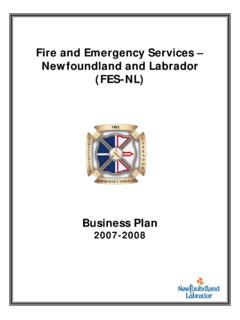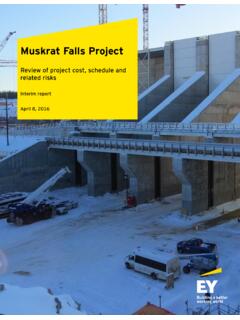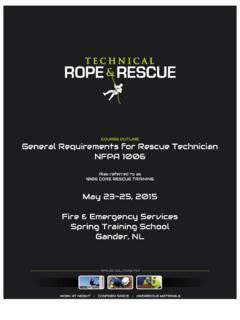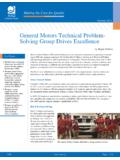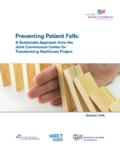Transcription of Mathematics 6 - Government of Newfoundland and Labrador
1 Mathematics 6. Curriculum Guide 2015. TABLE OF CONTENTS. Table of Contents Acknowledgements .. iii Foreword ..v Introduction ..1. Background ..2. Beliefs About Students and Mathematics Learning ..1. Affective Domain ..2. Goal for Students ..2. Conceptual Framework for K 9 Mathematical Processes ..3. Nature of Mathematics ..7. Essential Gradutaiton Learnings ..10. Outcomes and Achievement Indicators ..12. Summary ..12. Assessment and Evaluation ..13. Assessment Strategies .. 15. Instructional Focus Planning for Instruction .. 17. Teaching Sequence ..17. Instruction Time per Unit .. 17. Resources ..18. General and Specific 19. Unit 1: ..19. Unit 2: Number ..41. Unit 3: Patterns in Mathematics ..71. Unit 4: Data ..99. Unit 5: Motion ..133. Unit 6: Ratio & ..157. Unit 7: ..185. Unit 8: Multiplication and Division of Decimals..207.
2 Unit 9: ..229. Unit 10: 2D ..261. Unit 11: ..283. Appendix Outcomes with Achievement Indicators Organized by References ..311. Mathematics 6 CURRICULUM GUIDE 2015 i TABLE OF CONTENTS. ii Mathematics 6 CURRICULUM GUIDE 2015. ACKNOWLEDGEMENTS. Acknowledgements The Department of Education would like to thank the Western and Northern Canadian Protocol (WNCP). for Collaboration in Education, The Common Curriculum Framework for K-9 Mathematics - May 2006 and The Common Curriculum Framework for Grades 10-12 - January 2008, which has been reproduced and/or adapted by permission. All rights reserved. We would also like to thank the provincial Mathematics 6 curriculum committee, the Alberta Department of Education, the New Brunswick Department of Education, and the following people for their contribution: Trudy Porter, Program Development Specialist Mathematics , Division of Program Development, Department of Education Linda Stacey, Program Development Specialist Mathematics , Division of Program Development, Department of Education and Early Childhood Development Colin Barry, Teacher St.
3 Matthew's Elementary, St. John's Annette Bull, Teacher Glovertown Academy, Glovertown Wanda Bussey, Teacher Queen of Peace Middle School, Happy Valley Goose Bay Alvin Dominie, Teacher Sacred Heart Academy, Marystown Larry Doyle, Teacher Numeracy Support Teacher, Nova Central School District Guy Dupasquier, Teacher St. Edward's Elementary, Conception Bay South Regina Hannam, Teacher Lakewood Academy, Glenwood Cherry Harbin, Teacher St. Peter's Academy, Benoit's Cove Angela Hayden, Teacher Millcrest Academy, Grand Falls-Windsor Paulette Jayne, Teacher Sprucewood Academy, Grand Falls-Windsor Elaina Johnson, Teacher Bishop White School, Port Rexton Gina Keeping, Teacher Larkhall Academy, St. John's Annette Larkin, Teacher Topsail Elementary, Conception Bay South Damien Lethbridge, Teacher St. John Bosco, St. John's John Power, Teacher Numeracy Support Teacher, Eastern School District Sandra Rennie, Teacher St.
4 Lawrence Academy, St. Lawrence Daryl Rideout, Teacher Mary Queen of Peace, St. John's Roxanne Roberts, Teacher Beachy Cove Elementary, Portugal Cove St-Philip's Millie Walsh, Teacher Baie Verte Academy, Baie Verte Megan Wamboldt, Teacher Queen of Peace Middle School, Labrador City Mathematics 6 CURRICULUM GUIDE 2015 iii ACKNOWLEDGEMENTS. iv Mathematics 6 CURRICULUM GUIDE 2015. INTRODUCTION. INTRODUCTION. Background The Mathematics curriculum guides for Newfoundland and Labrador have been derived from The Common Curriculum Framework for K-9. Mathematics : Western and Northern Canadian Protocol, 2006. These guides incorporate the conceptual framework for Grades Kindergarten The curriculum guide to Grade 9 Mathematics and the general outcomes, specific outcomes communicates high and achievement indicators established in the common curriculum expectations for students.
5 Framework. They also include suggestions for teaching and learning, suggested assessment strategies, and an identification of the associated resource match between the curriculum and authorized, as well as recommended, resource materials. Mathematics 6 was originally implemented in 2010. Beliefs About Students are curious, active learners with individual interests, abilities and needs. They come to classrooms with varying knowledge, life Students and experiences and backgrounds. A key component in developing Mathematics mathematical literacy is making connections to these backgrounds and experiences. Mathematical Students learn by attaching meaning to what they do, and they need understanding is fostered to construct their own meaning of Mathematics . This meaning is best when students build on developed when learners encounter mathematical experiences that their own experiences and proceed from the simple to the complex and from the concrete to the prior knowledge.
6 Abstract. Through the use of manipulatives and a variety of pedagogical approaches, teachers can address the diverse learning styles, cultural backgrounds and developmental stages of students, and enhance within them the formation of sound, transferable mathematical understandings. Students at all levels benefit from working with a variety of materials, tools and contexts when constructing meaning about new mathematical ideas. Meaningful student discussions provide essential links among concrete, pictorial and symbolic representations of mathematical concepts. The learning environment should value and respect the diversity of students' experiences and ways of thinking, so that students feel comfortable taking intellectual risks, asking questions and posing conjectures. Students need to explore problem - solving situations in order to develop personal strategies and become mathematically literate.
7 They must come to understand that it is acceptable to solve problems in a variety of ways and that a variety of solutions may be acceptable. Mathematics 6 CURRICULUM GUIDE 2015 1. INTRODUCTION. Affective Domain A positive attitude is an important aspect of the affective domain and has a profound impact on learning. Environments that create a sense of belonging, encourage risk taking and provide opportunities for success To experience success, help develop and maintain positive attitudes and self-confidence within students must learn to set students. Students with positive attitudes toward learning Mathematics achievable goals and assess are likely to be motivated and prepared to learn, participate willingly themselves as they work in classroom activities, persist in challenging situations and engage in toward these goals. reflective practices.
8 Teachers, students and parents need to recognize the relationship between the affective and cognitive domains, and attempt to nurture those aspects of the affective domain that contribute to positive attitudes. To experience success, students must learn to set achievable goals and assess themselves as they work toward these goals. Striving toward success and becoming autonomous and responsible learners are ongoing, reflective processes that involve revisiting, asssessing and revising personal goals. Goals For The main goals of Mathematics education are to prepare students to: Students use Mathematics confidently to solve problems communicate and reason mathematically Mathematics education appreciate and value Mathematics must prepare students make connections between Mathematics and its applications to use Mathematics confidently to solve commit themselves to lifelong learning problems.
9 Become mathematically literate adults, using Mathematics to contribute to society. Students who have met these goals will: gain understanding and appreciation of the contributions of Mathematics as a science, philosophy and art exhibit a positive attitude toward Mathematics engage and persevere in mathematical tasks and projects contribute to mathematical discussions take risks in performing mathematical tasks exhibit curiosity. 2 Mathematics 6 CURRICULUM GUIDE 2015. MATHEMATICAL PROCESSES. CONCEPTUAL. FRAMEWORK The chart below provides an overview of how mathematical processes FOR K - 9 and the nature of Mathematics influence learning outcomes. Mathematics . Mathematical There are critical components that students must encounter in a Processes Mathematics program in order to achieve the goals of Mathematics education and embrace lifelong learning in Mathematics .
10 Students are expected to: communicate in order to learn and express their understanding Communication [C]. connect mathematical ideas to other concepts in Mathematics , to Connections [CN] everyday experiences and to other disciplines Mental Mathematics demonstrate fluency with mental Mathematics and estimation and Estimation [ME]. develop and apply new mathematical knowledge through problem problem solving [PS] solving Reasoning [R] develop mathematical reasoning Technology [T] select and use technologies as tools for learning and for solving Visualization [V] problems develop visualization skills to assist in processing information, making connections and solving problems. This curriculum guide incorporates these seven interrelated mathematical processes that are intended to permeate teaching and learning. Mathematics 6 CURRICULUM GUIDE 2015 3.

